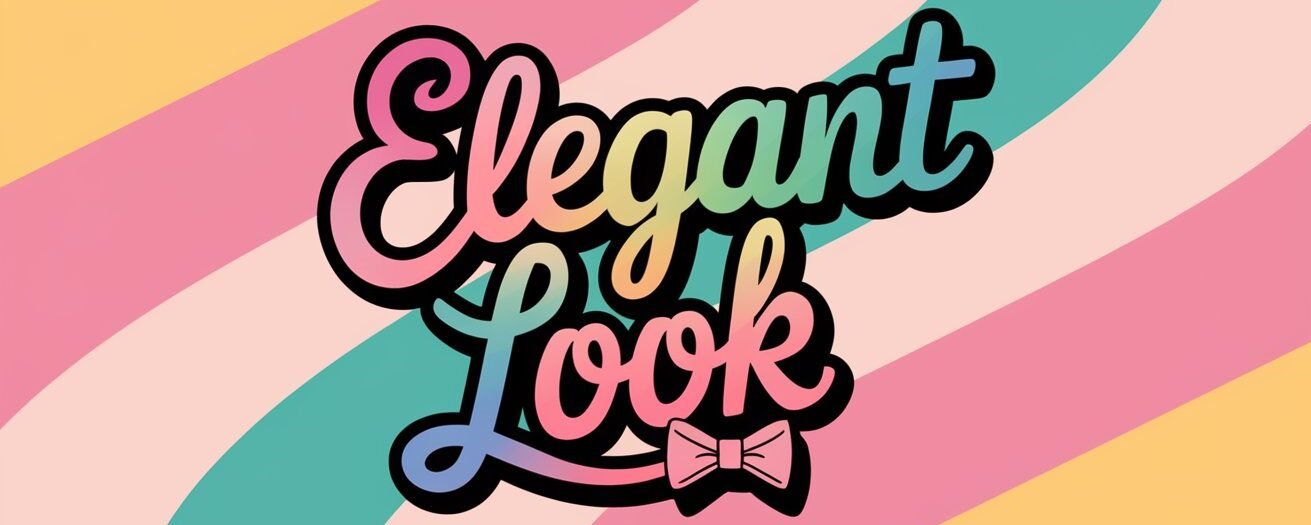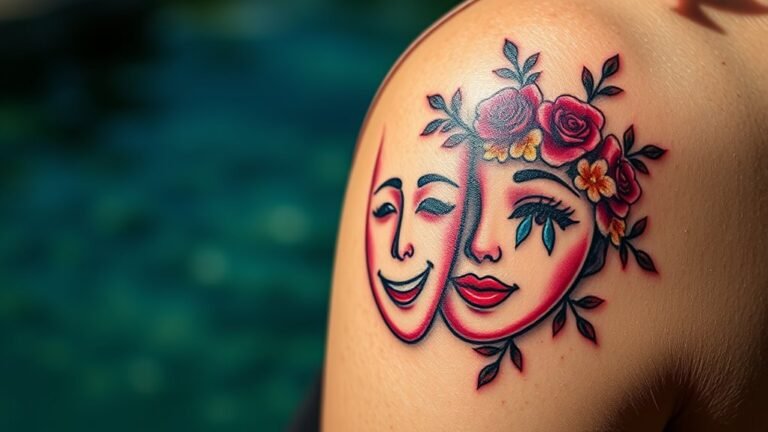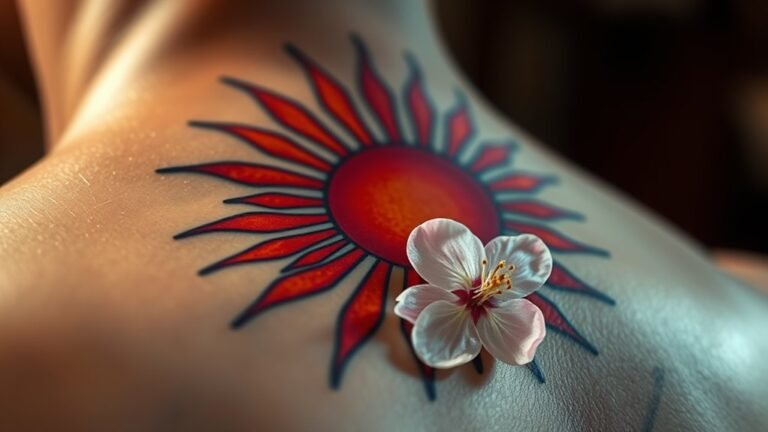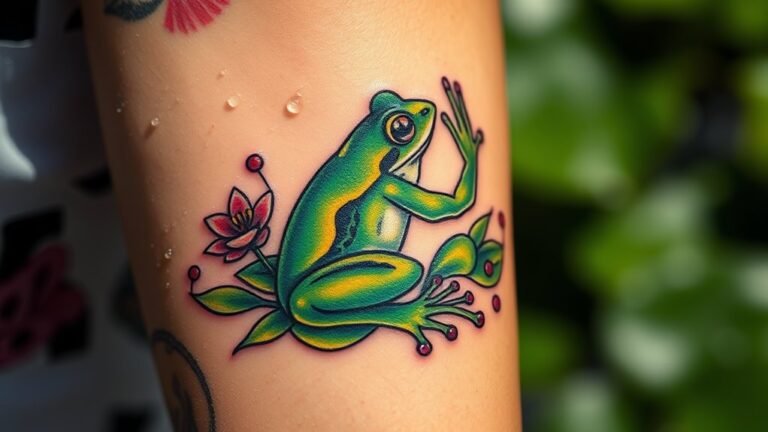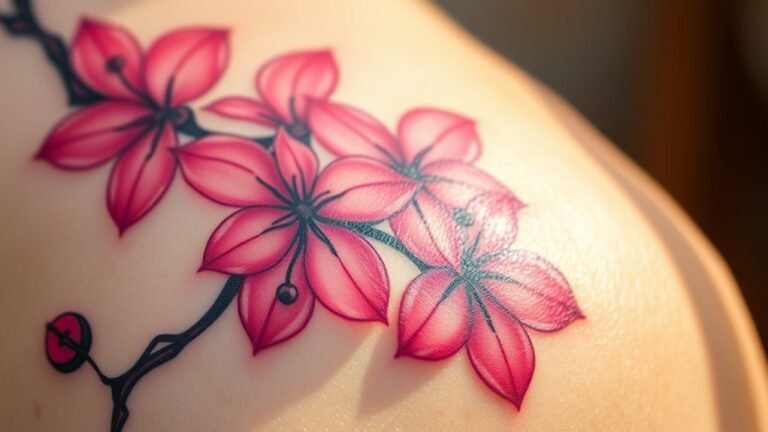Maori Face Tattoo Meaning and Symbolism
When you explore the world of Māori face tattoos, known as Ta Moko, you uncover layers of meaning that reflect identity, heritage, and personal stories. Each design you encounter is far more than mere decoration; it's a narrative woven from the threads of ancestry and life experiences. As you contemplate the significance of spirals and waves, you might find yourself questioning how these symbols connect individuals to their culture and community. What deeper insights might these tattoos reveal about the values and beliefs that shape Māori identity today?
In a Nutshell
- Ta Moko represents personal identity, heritage, and social status, reflecting the wearer's lineage and achievements within Māori culture.
- Designs incorporate spirals, waves, and geometric shapes, symbolizing growth, connection to the sea, and ancestral stories.
- Each tattoo conveys unique personal narratives, representing significant life events and fostering a strong sense of belonging within the Māori community.
- Tattoos indicate social status and familial connections, expressing pride and establishing one's place in the community's social hierarchy.
- Ta Moko also marks spiritual milestones, embodying ancestral connections and reflecting the wearer's journey through life and their cultural continuum.
Historical Significance of Ta Moko
When you look at a Māori face tattoo, or ta moko, you're not just seeing art; you're witnessing a profound expression of identity and heritage.
These tattoos are deeply rooted in traditional practices, reflecting the individual's lineage, achievements, and social status within their community. Each mark tells a story, connecting the wearer to their ancestors and cultural heritage.
Ta moko was historically significant, serving not only as a personal emblem but also as a way to preserve the Māori culture amidst colonial pressures.
By embracing these tattoos, individuals reclaim their identity and reinforce their connection to their past.
It's a powerful reminder that cultural expressions, like ta moko, are essential for fostering a sense of belonging and community.
Key Elements of Maori Designs
Understanding the key elements of Māori designs reveals a rich tapestry of symbolism and cultural significance.
When you look closely, you'll notice key patterns like spirals, waves, and geometric shapes, each holding deep meanings. Spirals often represent growth and evolution, while waves symbolize the connection to the sea, a crucial aspect of Māori identity.
The design elements also include intricate lines that weave together stories of ancestry and belonging. Each tattoo isn't just an art piece; it's a narrative of personal heritage.
By recognizing these elements, you appreciate the cultural depth behind the designs, fostering a sense of connection to a community that values tradition and storytelling.
Embracing this knowledge invites you into a world rich with meaning.
Personal Symbolism in Ta Moko
The intricate designs of ta moko—traditional Māori tattoos—carry profound personal symbolism that goes beyond aesthetic appeal. Each mark tells a unique story, reflecting your personal narratives and experiences.
When you wear ta moko, you're not just showcasing art; you're engaging in cultural expression that connects you to your heritage. The patterns often symbolize significant life events, achievements, or ancestral ties, making the tattoo a living representation of your journey.
This deep connection fosters a sense of belonging within the Māori community, allowing you to embrace your identity and share your story with others. Ultimately, ta moko becomes a bridge, linking your personal history to a collective cultural experience that enriches both your life and those around you.
Social Status and Identity
Māori face tattoos, or ta moko, reveal much about an individual's social status and identity within their community. Each design reflects not just personal stories but also broader tribal affiliations and cultural heritage.
When you see these tattoos, consider how they signify:
- Rank within the tribe
- Historical achievements
- Lineage and family connections
- The individual's role in society
These intricate patterns serve as a tapestry of identity, connecting you to your ancestors and heritage. They express pride and belonging, while also establishing your place within the social hierarchy.
Spiritual Connections and Beliefs
While exploring the meaning behind Māori face tattoos, you'll find that they're deeply intertwined with spiritual connections and beliefs.
These tattoos often represent significant milestones in one's spiritual journeys, marking personal growth and transformation. Each intricate pattern is more than just art; it embodies ancestral connections, linking individuals to their forebears and their stories.
When you look at ta moko, you're not just observing a design; you're witnessing a sacred narrative that honors lineage and identity. This deep-rooted spirituality fosters a sense of belonging within the community, reminding each wearer of their place in the continuum of life.
Ultimately, each face tattoo serves as a powerful reminder of the spiritual essence that binds past, present, and future.
Modern Interpretations of Ta Moko
As society evolves, so do the interpretations of ta moko, reflecting contemporary values and identities. Today, people embrace this form of art not just as a heritage symbol but as a personal expression of self. However, this raises important discussions around cultural appropriation.
- Ta moko as a revival of indigenous identity
- Contemporary expressions of personal and collective stories
- The fine line between appreciation and appropriation
- The impact of social media on tattoo culture
Navigating these interpretations can be complex. You might feel a strong connection to ta moko, yet it's crucial to approach it with respect and understanding.
Engaging with the cultural significance behind the art deepens your appreciation and fosters a sense of belonging within the broader community.
Cultural Preservation and Awareness
Understanding the significance of ta moko goes beyond its aesthetic value; it's essential for cultural preservation and awareness. When you engage with the art of ta moko, you're not just appreciating its beauty; you're tapping into a rich tapestry of Maori heritage.
This practice fosters cultural education, allowing you to explore the stories and traditions embedded in each design. By recognizing the historical context behind ta moko, you contribute to its heritage preservation, ensuring that these cultural narratives continue to thrive.
Embracing this knowledge creates a sense of belonging, connecting you with a community that values its roots. As you learn more, you help keep the spirit of ta moko alive, enriching both your understanding and the cultural landscape around you.
Frequently Asked Questions
Can Anyone Get a Maori Face Tattoo, Regardless of Heritage?
You can get a Māori face tattoo, but consider the implications. Cultural appropriation and tattoo ethics matter. Understanding the background and significance helps guarantee you respect the culture, fostering genuine connection rather than superficial belonging.
How Painful Is the Process of Getting a Ta Moko?
Getting a ta moko can be painful, but your pain tolerance plays a significant role. Different tattoo techniques can also impact your experience, so it's wise to prepare mentally and physically for the process ahead.
Are There Any Specific Rituals Before Receiving a Ta Moko?
Before receiving a ta moko, you'll likely experience rituals emphasizing their ritual significance and cultural importance. These practices foster a deep connection to heritage, ensuring you feel a sense of belonging within the community.
What Is the Typical Cost of a Maori Face Tattoo?
When considering the typical cost of a Maori face tattoo, you'll find pricing variations due to factors like artist experience, design complexity, and location. It's important to weigh these cost factors when planning your journey.
How Can One Care for a New Ta Moko Tattoo?
Caring for your new tattoo means following essential aftercare tips. Keep it clean and moisturized, avoiding sun exposure. Adhering to healing process guidelines helps guarantee vibrant colors and longevity, allowing your artwork to thrive.
